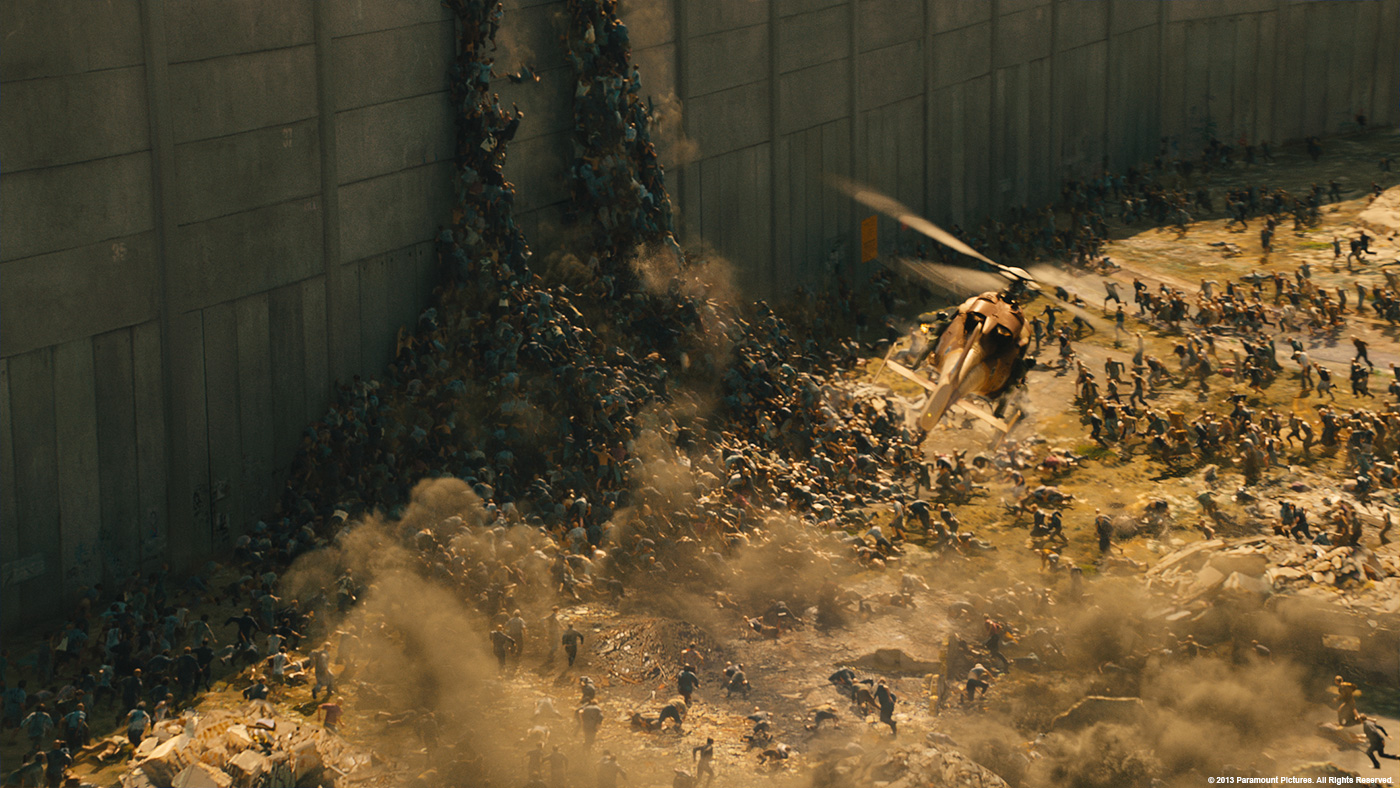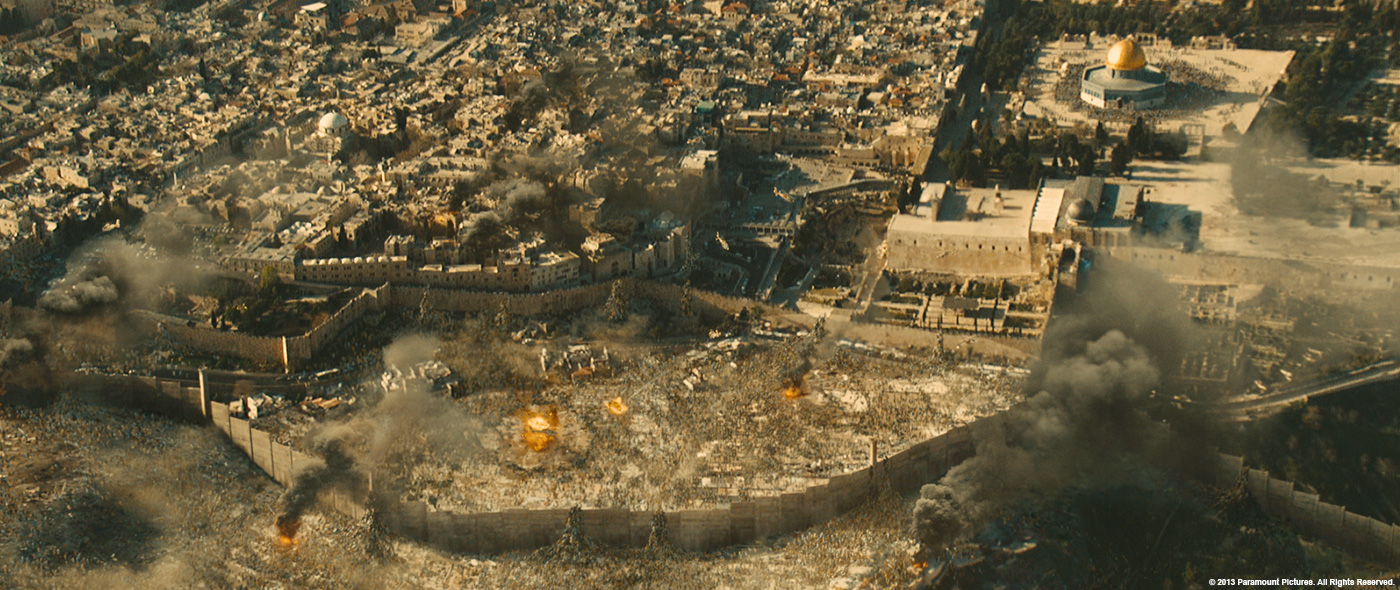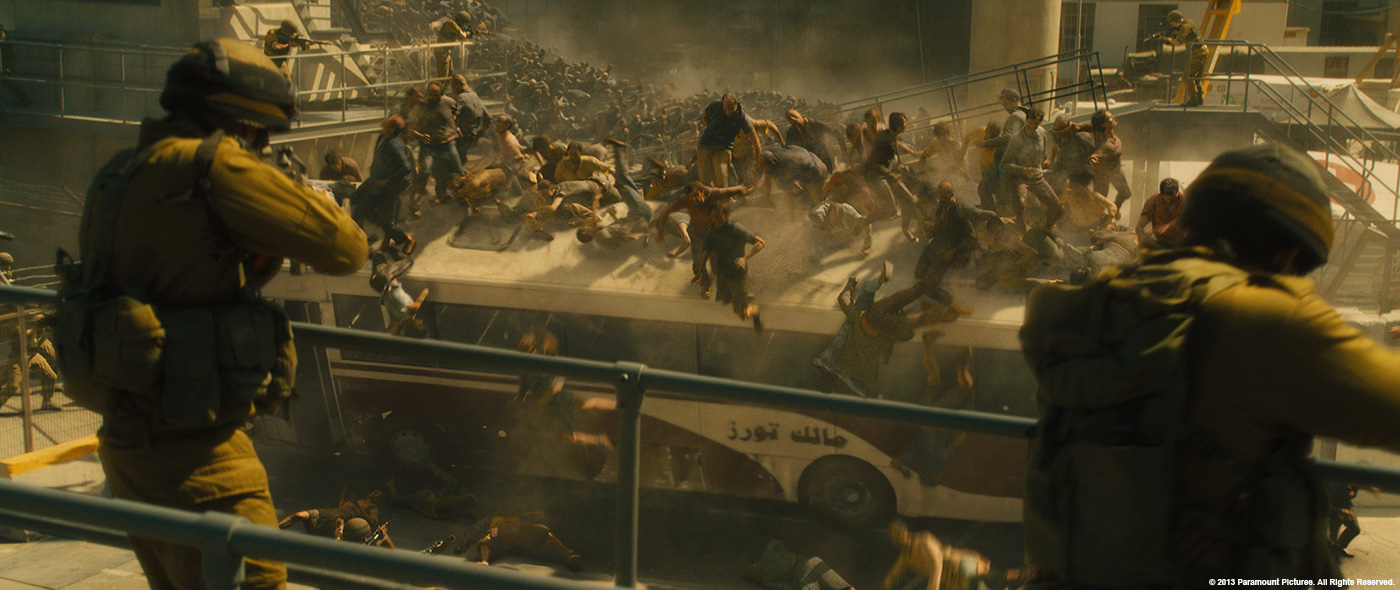Jessica Norman began her career in visual effects in 2001 at MPC. She has worked on projects such as LARA CROFT: TOMB RAIDER, ALIEN VS PREDATOR, CORPSE BRIDE, many HARRY POTTER or NIGHT AT THE MUSEUM: BATTLE OF THE SMITHSONIAN.
How was the collaboration with director Marc Forster?
It was a pleasure to work with Marc Forster, he’s a great director and I hope we will get the chance to work with him again.
How was the collaboration with Production VFX Supervisor Scott Farrar?
Scott has got a great eye and is very good at finding the essence of a problem and coming up with solutions.
What have you done on this show?
MPC completed more than 450 shots for WWZ, including all of the work in the Jerusalem sequence with zombie hordes, the plane crash sequence, the Wales sequence and the Epilogue.
How did you approach the impressive Jerusalem sequence?
It was clear from the beginning that one of our biggest challenges would be the large Z crowd scenes. Max Wood, cg supervisor on the show and in charge of the 3d pipeline, started planning early on for the different aspects of the challenge including building of a large crowd of humans and zombies, mocap clips needed, R&D updates (including tools for our in house crowd system ALICE) as well as planning for how we would be able to render these large and dense crowd scenes.
We set up a photo booth with our photographer James Kelly, on set in Malta where we photographed performers and extras. 2h3D scanned the same characters that we used to build a large crowd of humans and zombies.
What was the main challenges to recreate Jerusalem?
The Jerusalem scene was shot in Malta. In a variety of shots we had to slightly augment the cityscape by adding architecture from Jerusalem. We also created large 2.5d matte paintings of Jerusalem using photos taken on location by one of our compositing leads Lev Kolobov. The environment team lead by Thomas Mouraille built a 70 ft tall wall that was seen in many of the shots in ”Busland”.
It’s the wall that we see the zombies climb later on in the sequence. The wall was built using photo references of small pieces of the on-set wall as well as various other concrete build references. Outside the wall we created a large CG environment with derelict buildings. The wasteland environment was created using stills photography and aerial footage from Malta.
How did you recreates the various vehicles such as the helicopters?
2h3D scanned the various vehicles, MPC’s photographer James Kelly did the texture shoots of the vehicles that were then built back at MPC using Maya, Photoshop and Mari. MPC built a helicopter, a bus with texture variations, a passenger plane with texture variations, a smaller Cessna plane and a military Antanov plane.
The hordes of zombies are moving in a fresh new way. What were your references and indications for it?
During pre production we received reference material showing insects swarming and schools of fish formations as well as motion studies that had been made with performers overseen by the Production Animation Supervisor, Andy Jones. We also received concept work early on showing different formations that the Zombie crowds could take. These included pyramid formations and also tentacle-like shapes.
Can you tell us in details how you handle the crowd animation?
Animation supervisor Gabrielle Zucchelli worked closely with crowd lead Marco Carboni to make sure that our zombies moved in the right way when part of large crowds, interacting with live action and as hero digital doubles. MPC’s pipeline was adapted to be able to push single ALICE agents through to the animation department and then either keep them as hero or incorporate them back into the crowd simulation.
Part of the animation challenge was to match the live action performers Zombie movements and in some cases take it a step further. The Zombies keep on running even when their limbs are broken and attack prey head first, without pain. In all of the complex crowd shots we added quite a few layers of hand animated zombies.
Can you tell us more about how you used your crowd system ALICE?
Using ALICE our Crowd team went through a huge number of development tests trying to define what these Zombie effects should look like, many of the shots required us to leverage the power of PAPI, MPCs Physic API.
PAPI and ALICE are bridged together allowing us to create behaviours and animations in the crowd engine which can then also be used to drive physics simulations at the same time. This allowed the crowd team to weight in and out of ragdolls, create partial ragdolls and/or entirely/partially driven animations to choreograph the hordes of zombies which plough through Busland. Some of the zombies also had extra logic written so they could interact with their surroundings and other zombies.
PAPI is built on top of the Havok physics engine and is exposed as both a scrip-table and node based physics system to the TDs, which they can use to drive all manner of effects. Although being originally conceived for KINGDOM OF HEAVEN many years ago, WWZ was by far the most challenging combined rigid body and crowd simulation we have ever tackled.
Can you explain in details about the zombie creation?
Creating characters for the movie was a big task as we had to build so many unique humans and zombies. Characters were built from reference photography and scans gathered on set. Our Model Lead Ashley Tilley and Texture lead Jung Yoon Choi oversaw the asset team, creating 24 different body types, men women and children with lots of different texture variations. Each character was built as human, and at three different levels of zombification. Level three zombification being emancipated with missing hair, defined veins and wounds. Level one being zombies that just had been bitten, with a few bite marks or smaller wounds. The texture team created a library with wounds, blood stains, bite marks, rotten teeth etc that they would add to the zombies.
Each character was also built at four different levels of detail, hero (LOD A) for close ups through to LOD D for distance. LOD A B and C had groom with dynamics and full cloth simulations. LOD D was rendered with geometry hair and no cloth simulation. We used Maya, Zbrush, Photoshop, Mari and Nuke for building our assets.
For our large crowds we created an even bigger wardrobe. The wardrobe was designed so that any item of clothing could go together and each item would fit any body type. Clothing items were built to match the different zombification levels, dirty and torn for level three and clean for humans. Once built we decided on a crowd with 3000 variations, not one identical to another. Where needed, we could still go in and change the top or trousers of any character where it would make more sense for the shot.
The cloth and hair simulation team was lead by Edward Lim. For the larger crowds we used MPC solver, our in-house cloth solver that is well integrated with ALICE. We used ncloth for hero cloth simulations or where extra crowd cloth detail was needed.
How did you create the impressive shots with the zombies doing a pyramid?
We captured a wide variety of mocap clips for the different actions that we needed. For the pyramid shots we captured actions including climbing up ramps and a net. We started with the geometry and then populated it with clips based on inclination using ALICE. The larger pyramids typically included around 5000 agents. Once the pyramids were populated we started working on the detailing, adding animation vignettes with zombies climbing and falling as well as the various actions needed on the ground.
Can you tell us more about the render challenges of so many zombies?
Rendering the zombies in the large crowd shots was challenging in many ways. Once the crowd and animation work was complete we analyzed the scenes to work out how we could split up the crowd before passing them over to cloth simulation and lighting. We would work on different groups of zombies that could be rendered together, based on position and how close to camera every agent would appear throughout the shot. In quite a few shots, zombies that start in the background end up very close to camera. These agents all had to be rendered with a very high detailed characters. Our lighting leads Jon Attenborough and Wes Franklin worked closely with our compositing supervisor Jonathan Knight to break down the many passes and layers that made up the crowd. Compositing leads Lev Kolobov and Jeremy Sawyer then set up standardized Nuke templates that streamlined the compositing work flow. For the complex zombie shots we rendered deep passes allowing us to combine the different layers of the crowd.
How did you handle the plane destruction and the debris?
Most of the plane sequence was shot inside a section of plane on a gimble rig. Green screens were put up outside the windows and we comped in aerial plates shot in Wales. The plane was filled with extras and stunt performers to which we added CG crowd extensions. We also added plane extensions to a few shots.
In the movie a Zombie makes it into the cabin and starts an outbreak. Gerry throws a grenade and destroys part of the side of the plane. MPC enhanced the SFX teams explosion, adding vapour and debris, and cg Zombies who get sucked from the plane, as well as a cg wing and engine. In the shots where the camera is outside the plane, we added a full cg plane, debris, vapour and cg Zombies. The sequence ends with the plane crashing into trees and tumbling towards camera. A live action plate of the trees and ground was shot outside London. MPC added mountains to the background, replaced the centre section of trees with cg breakable trees and changed the sky. A cg plane was added and the FX team, lead by Oliver Winwood added layers of fx including a large flowline dust trail, tree parts and ground interaction. Live action elements were added in comp and were combined with the fx elements using deep passes. Asset lead, Leandre Lagrange, oversaw the up-resing of models and textures of our existing plane for the crash, this included a broken engine, wing and nose cone.
How did you created the UN research center in Wales?
The majority of the exterior of the building was shot in camera. MPC added a skybridge in between the two different buildings. For an establishing shots we created a 2.5d matte painting of the practical building which we added to the background.
Can you tell us more about your work on the Epilogue?
We created a few different shots for the Epilogue. One shot is a large 2.5D matte painting based on photography showing a large rubbish dump with large stacks of zombie bodies. The stacks were created with our crowd tool and then rendered. On top of the renders we added layers of matte painting and live action elements of smoke, fire and embers. We also built a couple of diggers that drive through the scene.
For another section we created large stacks of zombies climbing up a building. The environments were a combination of aerial plates and matte painting. We added flame thrower elements using live action fire elements.
For the stadium shot we created a large crowd of zombies that enter the stadium and get blown up by a large bomb. This shot was seen through a night / drone look.
What was the biggest challenge on this project and how did you achieve it?
The biggest challenge was the large zombie crowd shots in the Jerusalem. The challenge came from the complexity of the shots, and ensuring the many departments who worked on the sequence worked closely together. Great team work and some fantastic people on the show helped us overcome the challenges.
How long have you worked on this film?
MPC worked on WORLD WAR Z for over two years including pre production.
What was the size of your team?
The team size varied through the time that we worked on the project. Average size towards end was around 150 people.
What is your next project?
I’m afraid I can’t disclose that yet!
A big thanks for your time.
// WANT TO KNOW MORE?
– MPC: Dedicated page about WORLD WAR Z on MPC website.
© Vincent Frei – The Art of VFX – 2013

























